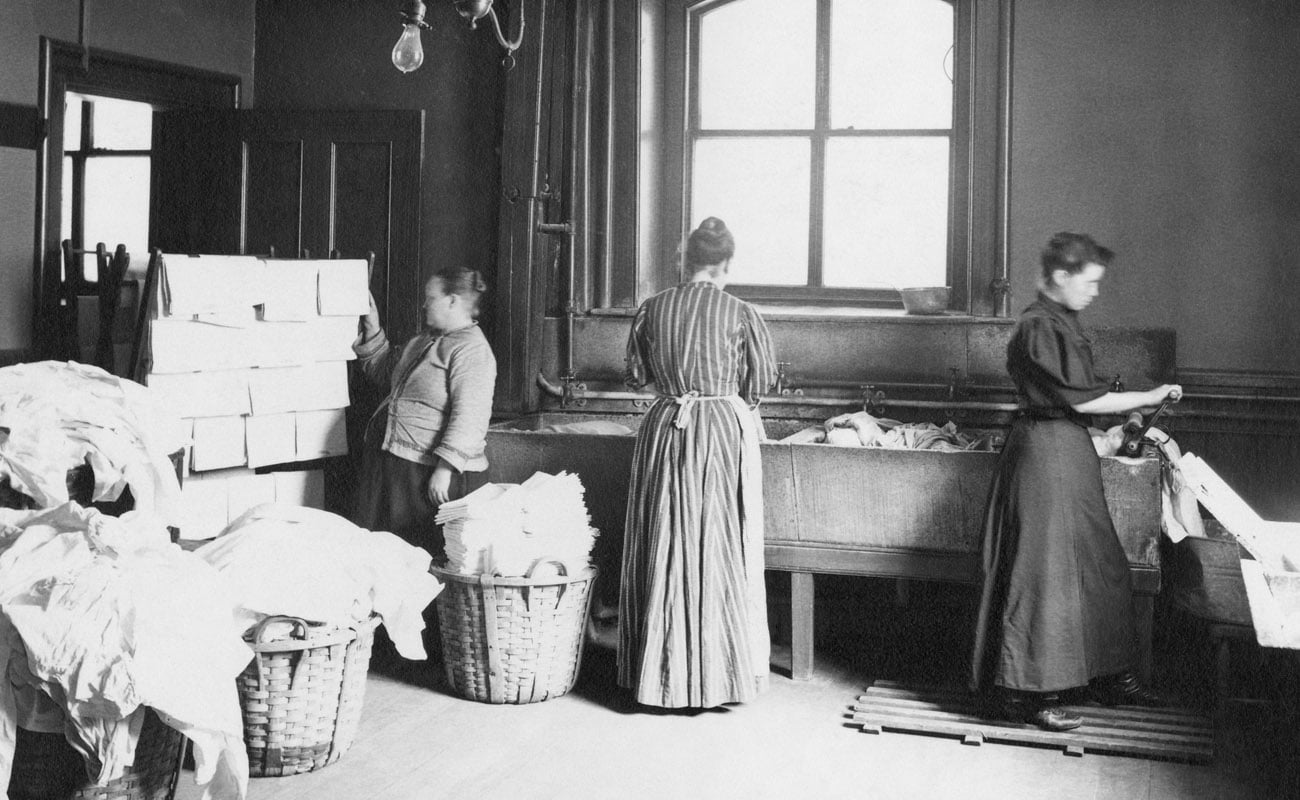In July 1907, Dublin mother Catherine Smith was ‘charged with grossly neglecting her four children, one of them an infant’ and she was subsequently sentenced to six weeks imprisonment.[1] It was reported in the Evening Herald that this ‘hopeless case’ and two of her children had entered the North Dublin Union (NDU) workhouse on 9 July 1907 and stayed for around two weeks.[2] After being discharged she was later found under the influence of alcohol by a workhouse officer who consequently charged her with ‘grossly neglecting’ her family. At the time he met her, she was returning to the workhouse. The newspaper reported that the accused’s husband was a soldier stationed in Malta and when he returned home ‘he found his room broken up and his children in the workhouse’.[3]
Catherine Smith represents just one of many ‘workhouse mothers’ whose lives are stamped throughout the surviving records of nineteenth- and twentieth-century institutions and whose stories were often publicly reported upon by the press. Catherine’s appearance in the newspaper is evidence of her society’s angst towards mothers who abused alcohol as she was directly challenging the perceived perception of femininity by neglecting her children and disrespecting her husband. To make matters worse, such abhorrent behaviour was a financial burden upon the poor rates. Catherine typified the impoverished mother whose seemingly deviant behaviours distorted the contemporary idealised version of motherhood. But what can we disentangle from these snippets of information? What can we understand about her use of the workhouse without falling into the contemporary stereotypes ourselves? Vilified in the press and through much of the public and official discourse, poor mothers and their reliance on state-funded relief, such as the workhouse, survive mostly in the records through their ‘deviant’ behaviours. However, we can piece together a broader analysis of their plight.
In post-Famine Ireland, the role of the workhouse altered as issues surrounding public health were increasingly falling under its remit. Additionally, there was a change within the admission trends which challenged the mechanisms of the workhouse means-testing system. Initially, admission into the workhouse was designed to assess applicants by a test of destitution.[4] The concept behind this was to ensure that only those in dire destitution would use the workhouse, thus preventing paupers from abusing the system. However, as the nineteenth century closed, more and more individuals frequented the workhouse on an ad-hoc basis and in incidents where short-term relief was warranted. This was reflective of the wider shifts in attitude towards poverty and unemployment.
Catherine Smith represents the shift in paupers’ admissions as she often utilised the NDU workhouse in a night-lodger capacity.[5] During these early years of the twentieth century, Dublin boasted some of the worst living conditions and levels of poverty throughout Europe. Mary E. Daly has explained that the issues of poverty which plagued Dublin mirrored the problems of other poor urban locations. Such concerns included experiences of ‘disability, drunkenness or simple misfortune [that] plunged many families into distress.’[6] To cope, the workhouse was used as a lifeline by destitute families, as we see with Catherine and her young children who had visited the NDU workhouse at least seventeen times by 1907.[7]
Significantly though, when traced within the workhouse records, it is apparent that Catherine’s use of the workhouse reflected more than just the neglectful alcoholic mother that the newspaper purported. In fact, Catherine’s reliance on the workhouse was also influenced by her experiences of domestic violence. Within the Board of Guardians minutes, an excerpt from a relieving officer in December 1904 insinuated that Catherine and her husband Thomas’ relationship was deeply dysfunctional:
Last night at 12.31 a woman named Catherine Smith, aged 31 and her two children, Anne aged 11, May aged 7 years, applied for admission to the Workhouse, she stated that her husband kicked her and inflicted several cuts to her head, she was dressed in Jervis St hospital, at the time she was recovering from the influence of drink, from inquiries I have made I am informed that both husband and wife were drinking since Saturday last, the children are in a wretched state barefooted and bare headed, the children informed me that they had got nothing to eat from early in the day. As this is not the first time for Mrs Smith to seek shelter of the Workhouse at late hours I request that the board will order that both husband and wife will be prosecuted.[8]
Indeed, it is clear from this incident that Catherine’s abuse of alcohol impacted negatively on her marriage and her children; such behaviour from women was regarded especially negatively.[9] More broadly, women’s dependence on alcohol represented the period’s contradictory outlooks towards femininity. As Conor Reidy has put it: ‘women were seen as dangerous and vulnerable, corrupting and corruptible.’[10] Mothers abusing alcohol were frequently noted upon in the case-studies of the National Society for the Prevention of Cruelty of Children (NSPCC), where Reidy notes that ‘drinking was the principal cause of child neglect and women in particular were singled out for their alcoholism’.[11] Though there appears to be no direct linkage between Catherine and the NSPCC, she very much fits into the demographic of mothers who found themselves under the society’s inspection.
Catherine’s interaction with the workhouse continued and she was arrested quite a few times for similar offences which resulted in various sentences to Mountjoy Prison.[12] Catherine’s last surviving record is her 1911 census return which listed her as the wife of labourer Thomas Smith and they were still living at Nerney Court, North Dublin with their now five children.[13] Despite the apparent cycles of abuse, Catherine and Thomas continued to grow their family and through their records we can trace together what domestic life was like for some poor and distressed families of early twentieth-century Dublin. Furthermore, through these records we receive a glimpse into the ways in which institutions such as the workhouses played a significant role in a young distressed family’s life.[14] Moreover, what this case clearly demonstrates is that the workhouse provided a space of refuge for Catherine to escape from an abusive marriage. It highlights that some women were capable of utilising the facility when needed and that the overrepresentation of women in the admission records does not necessarily signify that the workhouse was a place of containment, but rather, a place of refuge for women in need within a patriarchal society which provided little or no other alternatives. Case-studies like ‘hopeless’ Catherine’s are used within my research to explore what we can digest further from the sources to construct alternative narratives of ‘deviant mothers’ with the ambition of demonstrating the complexity of the workhouse and its role within the everyday lives of poor Irish mothers.
Note: This blog contains excerpts my from recent article: “A Hopeless Case’: the representation of mothers and the workhouse in Irish newspapers (1870-1910), History Studies, 20 (2019), 24-39. This article was constructed from research within a chapter of my PhD ‘Mothering in poverty: insitutionalised motherhood in Ireland, 1872-1908’, of which I presented a paper upon at the Irish History Student’s Association’s 2019 conference at Mary Immaculate College, Limerick. This paper was deemed one of the conference’s top presentations and was subsequently printed in the special edition of Historical Studies.
Judy Bolger is a PhD researcher in the department of Modern Irish History at Trinity College, Dublin. Her PhD examines the social discourse surrounding impoverished mothers and women’s experiences of maternity and motherhood in Irish workhouses during the late-nineteenth and early-twentieth centuries. This project is funded by the Trinity College, Dublin 1252 Postgraduate Research Scholarship. She received a first-class M.Phil. degree in Modern Irish History from Trinity College, Dublin (2017) in which her thesis research examined the social history of Irish breastfeeding during the nineteenth century. She also holds a first-class Honours B.A. Degree in English and History from Carlow College where her undergraduate thesis researched reproductive insanity.
[1] Evening Herald, 23 July 1907, p.2.
[2] Ibid., p.2.
[3] Ibid., p.2.
[4] Virginia Crossman, Poverty and the Poor Law in Ireland 1850-1914 (Liverpool University Press: Liverpool, 2013), p.113.
[5] Catherine Smith appears in the North Dublin Union Workhouse’s admission records and board of guardian minute books on various occasions during the period 1898-1905. See: National Archives of Ireland, ‘Admission and discharge records of the North Dublin Union Workhouse 1898-1905, BG 78/G 75; BG 78/G 76; BG 78/ G77; BG 78/G94.
[6] Mary E. Daly, Dublin: The deposed capital, a social and economic history, 1860-1914 (Cork: Cork University Press, 2011), p.77.
[7] Evening Herald, 23 July 1907, p.2.
[8] NDU, Board of guardian minute books, 1904-190, p.181.
[9] Conor Reidy, ‘Prostitution and the female criminal inebriate’, in Jennifer Redmond, Mary McAuliffe, Sandra McAvoy and others (eds), Sexual Politics in Modern Ireland (Dublin: Irish Academic Press, 2015), p. 57.
[10] Ibid., p.57
[11] Ibid., p.66.
[12] NAI, ‘Mountjoy Prison index general register female, 1901-1914, 1/44/2, 1/44/5, 1/48/6, 1/49/4.
[13] ‘Residents of a house 1.8 in Nerney’s Court (Rotunda, Dublin), Census of Ireland 1911.
[14] Ibid.

